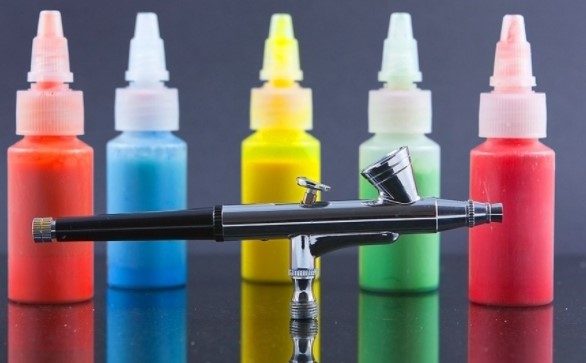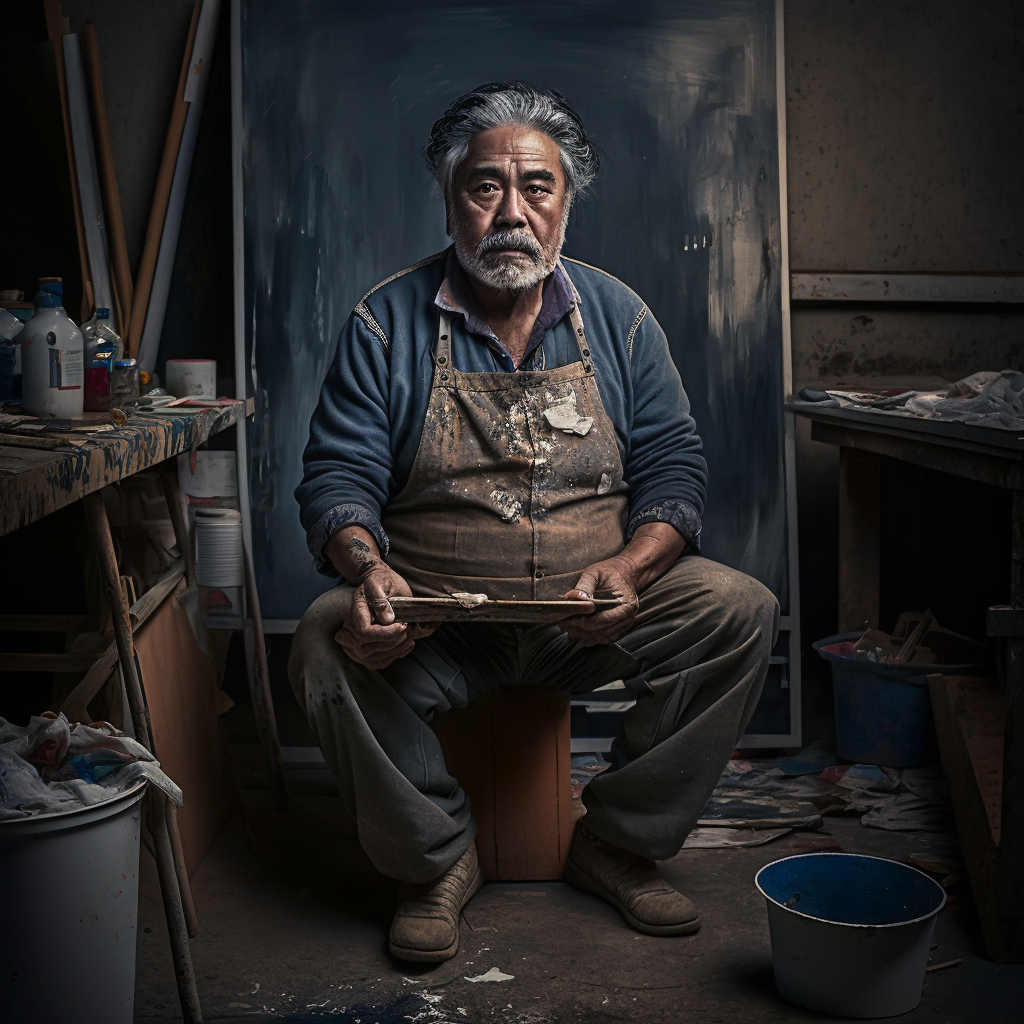Randy Charles is the owner of PaintCentric.com, a website dedicated to providing information, tips, tricks, and news about all things paint. With over 10 years...Read more
Are you trying to repair an airbrush? It can be a baffling and daunting task. You must first discover and troubleshoot the problem to get back to painting. This article offers tips for troubleshooting your airbrush. It’ll help you get back up and running in no time!

Let us investigate how to investigate and diagnose the issue:
Check the air pressure
Before changing the airbrush or spray head, use the right air pressure. This varies for each airbrush model, so check the user manual for the correct range.
If the spray head isn’t producing enough paint, see if the compressor is set to the correct pressure. Increasing it may help. Or, you may need to adjust the pressure & nozzle size.
If this doesn’t work, replace any clogged or worn-out components. Also, make sure all connections are secure. To fix uneven distribution or lack of paint flow, adjust the spray nozzle size & psi. Depending on the paint, it may be necessary to use a finely coned sprayer.
Check the needle size and condition.
Check your airbrush’s needle size and condition if it’s not spraying paint. It should be 1.4mm for best results. Inspect and replace the needle often. Ensure it’s lubricated with petroleum jelly for optimum performance.
Check the nozzle size and condition.
The nozzle on your airbrush can affect the spray pattern and performance. If you’re unhappy with the results, check the nozzle.
- Size is important – Nozzles range from 0.5mm to 1.5mm. For fine detail, try 0.35mm.
- Threads need to be tight but not too tight. Loose threads could affect the seal and your spray results.
- Inspect all components for corrosion, chipping and warping. If any damage is found, replace it to get better results from your airbrush setup.
Cleaning
Clean your airbrush! This is the first step when it stops spraying paint. A clogged airbrush may reduce airflow and paint flow. That’s why you need to keep it clean. If you don’t, it may not work correctly. So, make sure to clean your airbrush for proper functioning.
Clean the airbrush nozzle and needle.
The airbrush nozzle and needle are essential for spraying paint. The paint won’t flow properly if these components block or get damaged. Paint particles and pigment can build up inside and around the needle. To clear blockages, clean the nozzle and needle regularly.
- Use a cleaning brush or dedicated airbrush cleaning solution to clean the nozzle. For metal nozzles, you can use a solvent-based cleaner.
- If your kit comes with a tool for cleaning the needle, use it.
- Needle dipping is good for ceramic nozzles but can wear away all types of needles. Dip the needle in warm water (not boiling!) for 1-2 minutes. Then rinse from top to tip with running water to remove any particles. Put two drops of oil on before storing it in an upright position.
Cleaning your airbrush regularly helps keep your artwork or project precise and consistent.
Clean the airbrush cup and lid.
Start with the cup and lid when troubleshooting an airbrush. Gently take them out and see if they are damaged or clogged. Note: the passages are very small! Use a special brush for airbrush cups and lids to remove any residue. If that doesn’t work, use a damp cloth with Isopropyl alcohol. Ensure the cleaner is safe on plastic – some solvents can harm it.
If the needle broker channel is blocked, use a soft-bristled brush like a toothbrush or uncoiled paperclip tip. Cover the tip of the needle with a dry cloth and press it inwards with pin-point pressure to clear the blockage.
Clean the airbrush body and handle
Clean and maintain your airbrush body and regularly handle it for optimal performance. Paint can easily accumulate inside, causing clogged nozzles. This leads to either too fine atomized paint or no spray, affecting the painting.
Heat some isopropyl alcohol (IPA) and use a pencil brush to deliver short bursts of airflow into openings of the body. This loosens stuck particles. Use a soft cloth with a few drops of IPA to remove excess paint from all surfaces. Don’t apply too much pressure to avoid damaging components.
Maintaining your airbrush will keep it in great condition. Then you get beautiful, consistent results when painting!
Maintenance
Maintaining your airbrush is a must. Regular cleaning and upkeep are needed to guarantee the airbrush works well and the paint sprays evenly.
This part will concentrate on maintenance tips to help you spot and sort out issues with your airbrush if it isn’t spraying paint.
Replace the airbrush needle.

The needle of an airbrush is the metal part running down its center. It contains the nozzle at its tip. Over time, it may become clogged or bent, preventing it from spraying correctly.
If your airbrush doesn’t spray paint properly, check your needle. Replace it if it’s clogged or bent. Make sure you buy a needle designed for your type of airbrush.
Before changing the needle, wear protective eyewear and clean off any paint. Remove the old needle using pliers or tweezers. Insert a new one, making sure it fits snugly.
Adjust the tightness or looseness depending on the spray pattern you prefer. That way, you’ll get maximum efficiency when spraying.
Replace the airbrush nozzle.
Time can cause airbrush nozzles to get clogged and block a painter’s work. To prevent this, it is important to clean the nozzle. First, remove it from the airbrush. Different types of airbrushes and nozzles have different cleaning processes. Generally, these steps should be followed:
- Use a Phillips head screwdriver to remove any screws or components holding the nozzle.
- Soak the nozzle in warm water with mild dishwashing liquid for five minutes.
- Rinse the soap off with warm water until it’s clean.
- If particles are still stuck, use an old toothbrush dipped in vinegar to loosen them.
- Dry the nozzle off with a soft cloth and inspect for any damage.
- When reattaching the nozzle, ensure all components are firmly locked.
Replace the airbrush cup and lid.
If your airbrush isn’t spraying paint, there may be an issue with the cup and lid. Bits of dried paint can clog the airflow, preventing paint from coming out. To fix this, remove the lid and cup and throw them away. Buy replacements designed for your airbrush model, and secure them firmly. You should then get a stronger, more consistent spray pattern.
Additionally, cleaning each component after use and changing worn-out parts is essential. Doing this will help ensure your airbrush keeps providing great results.
Airbrush Techniques

Airbrushing is a precise and easy way to paint. Are you experiencing difficulties with your airbrush? There could be several causes. Here, we will examine the different airbrush techniques and why your airbrush may not be spraying. Let’s get started!
Adjust the air pressure.
Changing air pressure is important when fixing airbrush issues. Low pressure usually means a fine spray, while high pressure will make the spray wider. Users often set the pressure too low, leading to overspray or no paint.
Read your equipment manual first. Most airbrushes have a knob on the back or body to adjust pressure. Each device has a different range, but usually between 1-60 psi.
Start at one end of the range and move to the other until you see the spray pattern you want. Change the pressure gradually – don’t go too quickly, or you can damage the airbrush and environment.
Adjust the paint flow.
Altering the paint flow is an essential airbrush skill. It’s easy, but you must be careful with the trigger. Make sure your airbrush is clean and lubricated.
Start by controlling the air pressure and lightly pressing the trigger. Increase the pressure slowly. This changes the thickness or thinness of the paint. You can make intricate designs with this.
Practice, and you will feel the pressure and distance needed to get the desired patterns. Different paints require different pressures, so experiment.
Adjust the distance from the surface.
Your airbrush’s distance from the surface you spray is a major part of getting good paint coverage. Typically, 2 – 4 inches is the best gap to have. If you have too little distance, the paint may splatter. And if you have too much distance, the paint won’t reach the surface like you want.
Test sprays and adjusting the air pressure can help you find the best distance and settings. Experimenting with different distances can show you which settings are best for different materials and how quickly or easily the paint will lay down. With some patience, you can gain control of the paint quantity and quality from your airbrush setup.
Troubleshooting Tips
Is the airbrush not spraying paint? Worry not! There are easy solutions. Clean your airbrush or adjust the air pressure. These are just some ideas to get your airbrush back in action. Let’s check out more tips!
Use the right type of paint.
Poor performance can result if the wrong paint is used for airbrushing. It is important to select the right type of paint. Look for paint made for airbrushing. Craft paints may be too thick and cause clogging or a rough sprayed surface. The paint must be adjusted for viscosity. Some paints are not adjustable.
The best paints for airbrushing include:
- Water-based acrylics adjust easily with water, and clean-up is easy.
- Urethanes – they flow smoothly and offer a tough coating.
Acrylics are best for beginners. They are cheaper, easier to clean, and simpler to learn with. Be sure the paint is labeled “for airbrush use only“. That will give better results than standard craft paints.
Use the right type of thinner.
Always thin your airbrush paint, even if the manufacturer says it’s ready to use. This will help it flow and prevent clogs. Different thinners are recommended for different types of paint.
- Lacquer or acrylic-based paints require a dedicated thinner or retarder. They’ll balance out the evaporative properties, reducing dry spraying.
- Water-based paints usually need distilled water for thinning and cleaning.
Make sure the thinner you use is compatible with the paint. Mixing different thinners can cause problems and might damage your airbrush.
Practice proper airbrush technique.
The Airbrush technique takes practice. Keep air and paint amounts consistently for even coverage. Start with low settings—point the nozzle towards the desired area. Increase settings as you learn more. Move your hand steadily for an even finish. Don’t move too fast or slow. Check connections for cracks or gaps.
You’ll learn why your airbrush isn’t spraying correctly with practice and maintenance!
Frequently Asked Questions
What should I do if the nozzle is blocked?
If the nozzle on your airbrush is blocked, clean it with a brush and some cleaning solvent. Make sure to rinse it thoroughly with water before you start spraying again.
What is the best way to adjust the air pressure?
The best way to adjust the air pressure is to increase it until you get the desired effect gradually. Keep an eye on the pressure gauge and adjust it accordingly.

Randy Charles is the owner of PaintCentric.com, a website dedicated to providing information, tips, tricks, and news about all things paint. With over 10 years of experience in the painting industry, Randy has become an expert in the field and is passionate about helping others learn more about painting. He has written numerous articles on the subject and is committed to providing accurate and up-to-date information to his readers.
- Latest Posts by Randy Charles
-
How Much Do You Tip Painters? The Ultimate Guide
- -
Can You Paint Over Rust Converter?
- -
Can You Paint Inside When It Is Raining?
- All Posts
